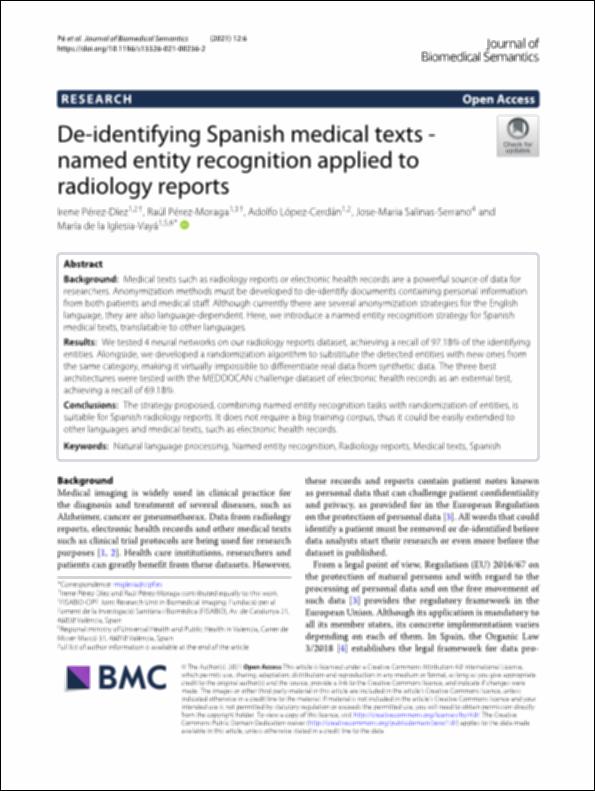Please use this identifier to cite or link to this item:
http://hdl.handle.net/10637/13662De-identifying Spanish medical texts-named entity recognition applied to radiology reports
| Title: | De-identifying Spanish medical texts-named entity recognition applied to radiology reports |
| Authors : | Pérez Díez, Irene Pérez Moraga, Raúl López Cerdán, Adolfo Salinas Serrano, José María Iglesia Vayá, María de la |
| Keywords: | Proceso de lenguaje natural.; Natural lenguage processing.; Radiología.; Data protection.; Diagnóstico radiológico.; Diagnosis, Radioscopic.; Protección de datos personales.; Radiology. |
| Publisher: | BioMed Central |
| Citation: | Pérez-Díez, I., Pérez-Moraga, R., López-Cerdán, A., Salinas-Serrano, J.M. & Vayá, M.I. (2021). De-identifying Spanish medical texts - named entity recognition applied to radiology reports. Journal of Biomedical Semantics, vol. 12, art. 6 (29 mar.). DOI: https://doi.org/10.1186/s13326-021-00236-2 |
| Abstract: | Background: Medical texts such as radiology reports or electronic health records are a powerful source of data for researchers. Anonymization methods must be developed to de-identify documents containing personal information from both patients and medical staff. Although currently there are several anonymization strategies for the English language, they are also language-dependent. Here, we introduce a named entity recognition strategy for Spanish medical texts, translatable to other languages. Results: We tested 4 neural networks on our radiology reports dataset, achieving a recall of 97.18% of the identifying entities. Alongside, we developed a randomization algorithm to substitute the detected entities with new ones from the same category, making it virtually impossible to differentiate real data from synthetic data. The three best architectures were tested with the MEDDOCAN challenge dataset of electronic health records as an external test, achieving a recall of 69.18%. Conclusions: The strategy proposed, combining named entity recognition tasks with randomization of entities, is suitable for Spanish radiology reports. It does not require a big training corpus, thus it could be easily extended to other languages and medical texts, such as electronic health records. |
| Description: | Este artículo se encuentra disponible en la siguiente URL: https://jbiomedsem.biomedcentral.com/track/pdf/10.1186/s13326-021-00236-2.pdf |
| URI: | http://hdl.handle.net/10637/13662 |
| Rights : | http://creativecommons.org/licenses/by/4.0/deed.es |
| ISSN: | 2041-1480 (Electrónico) |
| Issue Date: | 29-Mar-2021 |
| Appears in Collections: | Dpto. Matemáticas, Física y Ciencias Tecnológicas |
Items in DSpace are protected by copyright, with all rights reserved, unless otherwise indicated.


